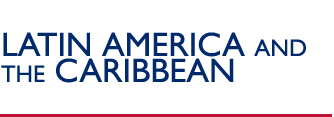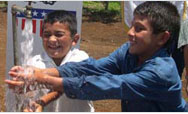 |
 |
|
 |
 |
|
 |
 |
|
 |  | |
 |
 |
 |
USAID Information:
External Links:
|
|
 |
 |
|
USAID Assists Peru After Devastating Earthquake
September 14, 2007
On August 15 at 1840 hours local time, a magnitude 8.0 earthquake struck near the town of Chicha Alta, 95 miles south-southeast of Lima along the Pacific coast, according to the U.S. Geological Survey. The earthquake killed approximately 500 people, injured at least 1,000 others, and destroyed more than 16,000 homes according to the Government of Peru’s (GOP) civil defense agency (INDECI) and the U.N. Office for the Coordination of Humanitarian Assistance. The GOP declared a state of emergency in the Department of Ica and Cañete Province, and INDECI deployed assessment teams to Ica and Chincha provinces.
On August 16, U.S. Ambassador P. Michael McKinley declared a disaster due to the effects of the earthquake. In response, USAID/OFDA provided an initial $100,000 through USAID/Peru for the local purchase and transport of emergency relief supplies to the most affected areas in the Department of Ica. USAID/OFDA also deployed a six-person assessment team. A joint U.S. Embassy and USAID team is assessing conditions and providing regular updates on affected areas.
Peru Earthquake - Fact Sheet #4 - September 5, 2007 (pdf, 50kb)
Peru Earthquake - Map #4 - September 5, 2007 (pdf, 319kb)
BACKGROUND AND KEY DEVELOPMENTS
- Between September 11 and 13, USAID/OFDA airlifted an additional 800 rolls of plastic sheeting from the
USAID/OFDA warehouse in Miami to help meet continuing shelter needs. The total value of the plastic sheeting,
including transport, is $337,690.
- With funding from USAID/OFDA, CARE, Caritas, and World Vision will provide temporary shelter solutions to a
combined total of 3,000 to 4,500 families in Cañete, Chincha, Ica, and Yauyos provinces. The plastic sheeting airlifted
by USAID/OFDA will be used as part of this shelter program. The Peruvian Corps of Voluntary Firefighters, with
which USAID/OFDA has had a long-term technical assistance and training relationship, will provide support to the
non-government organizations for program implementation.
NUMBERS AT A GLANCE *
| Total Affected Population | 519 killed, 1,844 injured | Source: INDECI1, September 11, 2007 |
|---|
| Houses Destroyed | 52,891 houses | Source: INDECI, September 11, 2007 |
|---|
| Houses Damaged | 22,939 houses | Source: INDECI, September 11, 2007 |
|---|
*Based on preliminary estimates. Assessments to determine precise damage and affected population figures are ongoing.
1 Peruvian National Institute of Civil Defense (INDECI) "
FY 2007 HUMANITARIAN FUNDING PROVIDED TO DATE
USAID/OFDA Assistance to Peru: $2,551,910
Total USAID Humanitarian Assistance to Peru: $2,551,910
Total Department of Defense (DOD) Humanitarian Assistance to Peru: $600,000
Total USG Humanitarian Assistance to Peru: $3,151,910
CURRENT SITUATION
- The USAID assessment team reported that the center of the emergency response is shifting from Pisco Province to
other affected areas, including Ica, Chincha, and Cañete provinces. As local authorities play a larger leadership role in
the response, INDECI is strengthening local Emergency Operations Centers and is working closely with authorities to
validate information and numbers of affected persons, as well as provide relief assistance.
- The U.N. Development Program has begun coordinating the U.N. Emergency Team, following the departure of the
U.N. Disaster Assessment and Coordination (UNDAC) team.
- Between September 4 and 7, the USAID team conducted assessments of earthquake-affected districts in Chincha,
Canete, and Ica provinces. In Chincha Province, the team visited the districts of Pueblo Nuevo, Grocio Prado,
Sunampe, and Chincha. The USAID team also visited the municipality of Guadalupe in Salas District, Ica Province.
The USAID team found severe damage in the areas visited in Chincha and Guadalupe, with nearly all adobe brick
structures having collapsed. While cleanup efforts are ongoing, there are still large quantities of rubble to be removed
in both areas. The USAID team concluded that the main need in Chincha is heavy machinery for rubble removal.
Emergency Needs
- According to the USAID team, the main emergency needs in the earthquake-affected areas are rubble removal, water
and sanitation, and camp management. The large quantities of rubble in all affected areas are delaying efforts in
shelter activities, as well as in the recovery and reconstruction phases.
Shelter
- The Government of Peru (GOP) has revised its shelter strategy for the affected areas to focus on people staying or
returning to their house lots, rather than continuing to live in displaced persons camps.
- USAID supports the GOP’s new strategy and will expand the USAID/OFDA-funded temporary shelter program to
include the cleanup of house lots and the rehabilitation of water and sanitation systems. Through this program,
CARE, Caritas, and World Vision will provide temporary shelter solutions to a combined total of 3,000 to 4,500
families in Cañete, Chincha, Ica, and Yauyos provinces. As part of the program, USAID/OFDA partners are
distributing 1,100 rolls of plastic sheeting as materials for temporary shelters.
- On September 3, the International Organization for Migration (IOM) received the first shipment of 5,000 winterized
tents for distribution in earthquake-affected areas. IOM plans to distribute 3,500 tents in Pisco Province, 1,000 tents
in Chincha Province, and 500 tents in Ica Province.
Water and Sanitation
- The USAID team noted that current water and sanitation facilities are not sufficient in displaced persons camps. On
September 6, the U.N. Office for the Coordination of Humanitarian Affairs also reported that sanitation remains an
issue in displaced persons camps.
- In Cañete Province, Lima Region, the USAID team visited the rural district of Lunahuaná on September 4 to assess
the ongoing emergency response. The USAID team indicated that Lunahuaná’s main challenge is to repair the water
system, which is intermittently functioning with service provided on a rotating basis to different sectors of the district.
District authorities reported that water service in the outlying towns has yet to be restored, and the district provides
water to these areas via a tanker truck.
- As part of the USAID/OFDA-supported shelter assistance program, CARE, Caritas, and World Vision are providing
water, sanitation, and hygiene support to affected areas in Cañete, Chincha, Ica, and Yauyos provinces.
USG HUMANITARIAN ASSISTANCE
- Following the August 16 U.S. Ambassador’s disaster declaration for Peru, more than 50 personnel from the
Department of State, USAID/Peru, USAID/OFDA, and the DOD’s Military Assistance Advisory Group (MAAG)
were in the affected areas, conducting assessments, coordinating with the GOP, providing emergency medical
treatment and relief supplies, and assisting American citizens.
- USAID/OFDA has provided $1.5 million through USAID/Peru to implementing partners, including the Peruvian Red
Cross, CARE, Caritas, and World Vision to support relief efforts.
- In addition to financial assistance, USAID/OFDA has delivered emergency relief commodities via six airlifts to Peru.
The commodities included four 10,000-liter water bladders, 7,800 ten-liter water containers, 500 body bags, 1,100
rolls of plastic sheeting, and 15,000 blankets. USAID/OFDA has also provided an office support module for the
UNDAC team.
- Begining August 16, a USAID assessment team comprising representatives from USAID/OFDA and USAID/Peru
assessed damages, identified needs, and delivered emergency assistance, in collaboration with the U.S. Embassy, and
MAAG.
- To date, DOD has provided approximately $600,000 in technical and financial assistance in response to the
earthquake. DOD medical teams provided critical health services in the affected areas as well as supplies and air
support.
Back to Top ^
|


